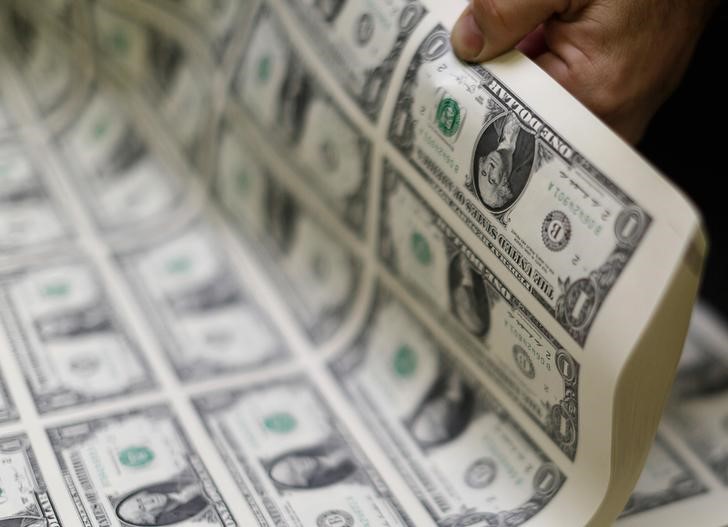Forex
Dollar muted in thin trading; retail sales to drive rate cut expectations


© Reuters.
Investing.com – The U.S. dollar traded in a muted fashion in early European trade Monday, with a U.S. holiday limiting activity as traders consider the chances of early rate cuts by the Federal Reserve.
At 04:35 ET (09:35 GMT), the Dollar Index, which tracks the greenback against a basket of six other currencies, traded 0.1% higher at 102.242, at the start of the Martin Luther King Jr. Day holiday.
Dollar faces quiet week
U.S. unexpectedly fell in December, according to data released Friday, prompting traders to increase their bets that the will start cutting interest rates early this year.
Market pricing now points to a 78% chance that the U.S. central bank will begin easing rates in March, as compared to a 68% chance a week ago, according to the CME FedWatch tool.
The U.S. data calendar is pretty quiet this week, with the main focus being Wednesday’s . This will be closely watched for indications that consumer spending – a major driver of economic growth – is remaining resilient in the face of elevated interest rates.
Retail sales are expected to have risen 0.4% in December, after a 0.3% increase in November.
“We suspect that the data may prove insufficient to trigger a USD rebound for now; the consensus view of a dollar decline later this year seems to be making investors keen to sell dollar rallies,” said analysts at ING, in a note.
Investors will also have the chance to hear from several Fed officials including Fed Governor as well as Atlanta Fed President and San Francisco Fed head .
Euro edges higher despite German GDP contraction
In Europe, edged higher to 1.0953, despite showing the German economy, the largest in the eurozone, contracted by 0.3% in the final quarter of last year and shrank by the same amount over the full-year 2023.
“Overall economic development faltered in Germany in 2023 in an environment that continues to be marked by multiple crises”, said Ruth Brand, president of the Federal Statistics Office earlier Monday.
Still, despite this weakness, recent inflation data broadly confirmed current thinking at the European Central Bank, meaning interest rate cuts are not a near-term topic of debate, chief ECB economist Philip Lane said on Friday.
rose to 2.9% in December, from 2.4% in November.
fell 0.1% to 1.2738 ahead of a busy week for U.K. economic data, including numbers on Tuesday, on Wednesday and on Friday.
“Services inflation is what matters the most for the Bank of England at the current stage and we expect to see it at 6.1% this week, considerably below the Bank of England’s estimates. Despite the improvement in services disinflation, 6%+ remains too high and is unlikely to make the BoE endorse dovish rate expectations just yet,” added ING.
Yuan slips slightly after PBOC stays on hold
In Asia, rose 0.1% to 7.1735, with the yuan retreating after the People’s Bank of China unexpectedly kept medium-term lending rates unchanged, suggesting the PBOC has limited headroom to loosen monetary policy further and support the Chinese economy.
Fourth-quarter data, due on Wednesday, is expected to show that the Chinese economy grew more than the government’s 5% target for 2023. But the growth also comes from a low base for comparison from 2022.
traded 0.4% higher to 145.51, with the yen suffering from persistent bets that the Bank of Japan will largely maintain its ultra-dovish policy when it meets later this month.
Japanese data, due later this week, is expected to show a sustained decline in inflation.

 Forex3 years ago
Forex3 years agoForex Today: the dollar is gaining strength amid gloomy sentiment at the start of the Fed’s week

 Forex3 years ago
Forex3 years agoUnbiased review of Pocket Option broker

 Forex3 years ago
Forex3 years agoDollar to pound sterling exchange rate today: Pound plummeted to its lowest since 1985

 Forex3 years ago
Forex3 years agoHow is the Australian dollar doing today?

 Cryptocurrency3 years ago
Cryptocurrency3 years agoWhat happened in the crypto market – current events today

 World3 years ago
World3 years agoWhy are modern video games an art form?

 Commodities3 years ago
Commodities3 years agoCopper continues to fall in price on expectations of lower demand in China

 Economy3 years ago
Economy3 years agoCrude oil tankers double in price due to EU anti-Russian sanctions





















